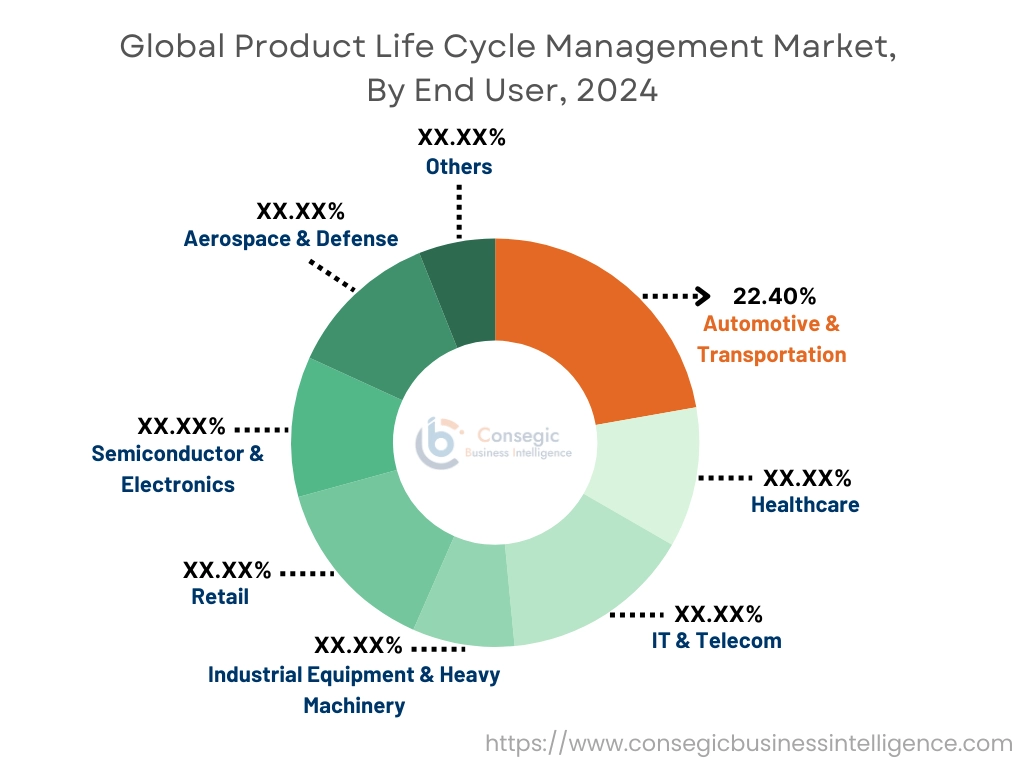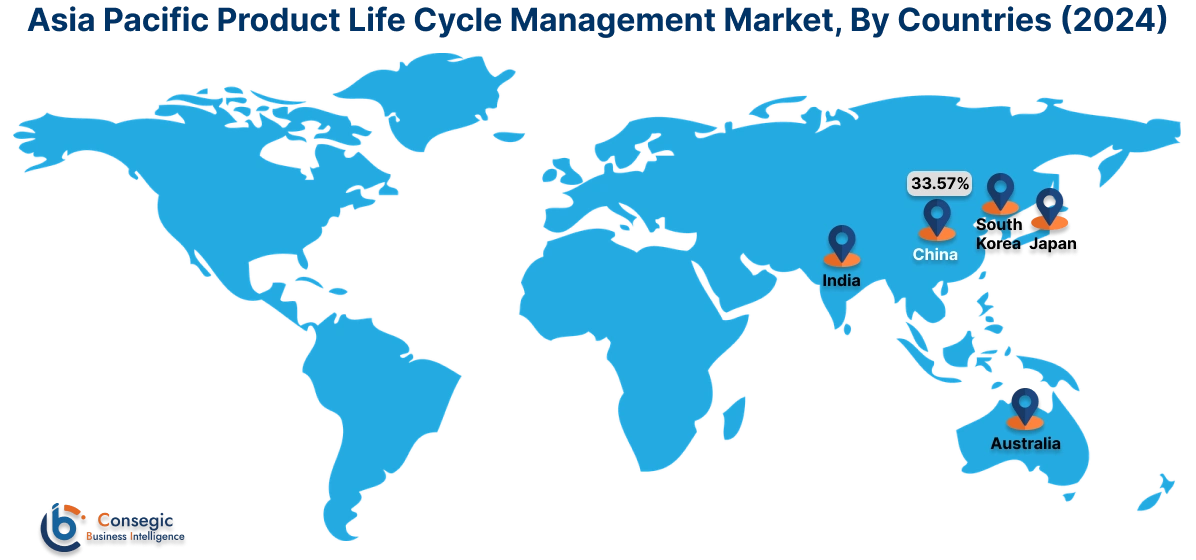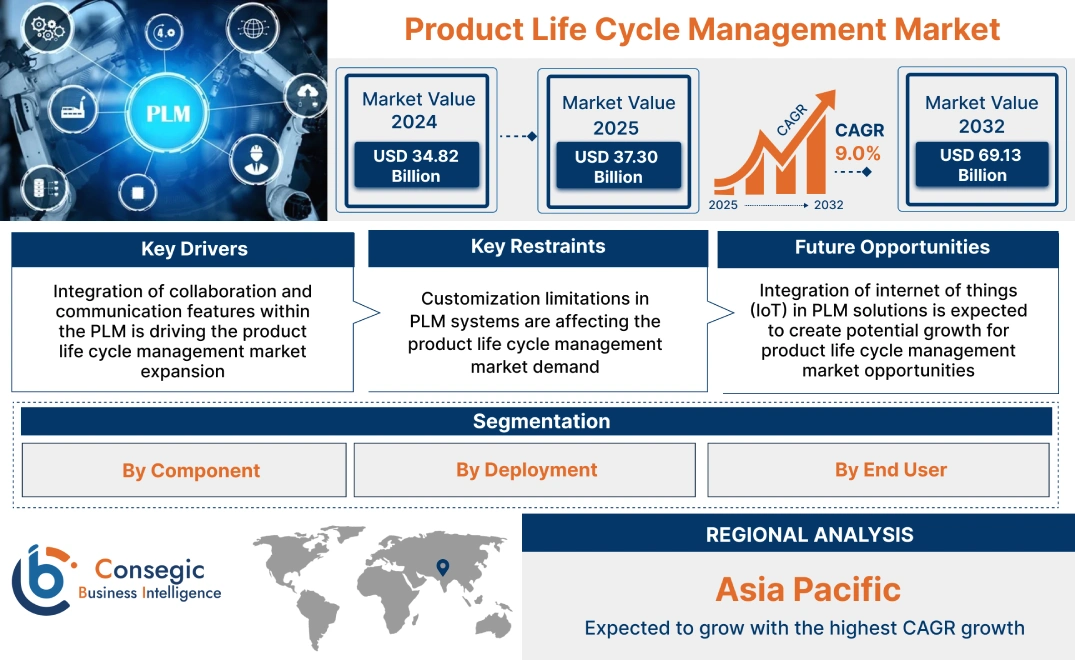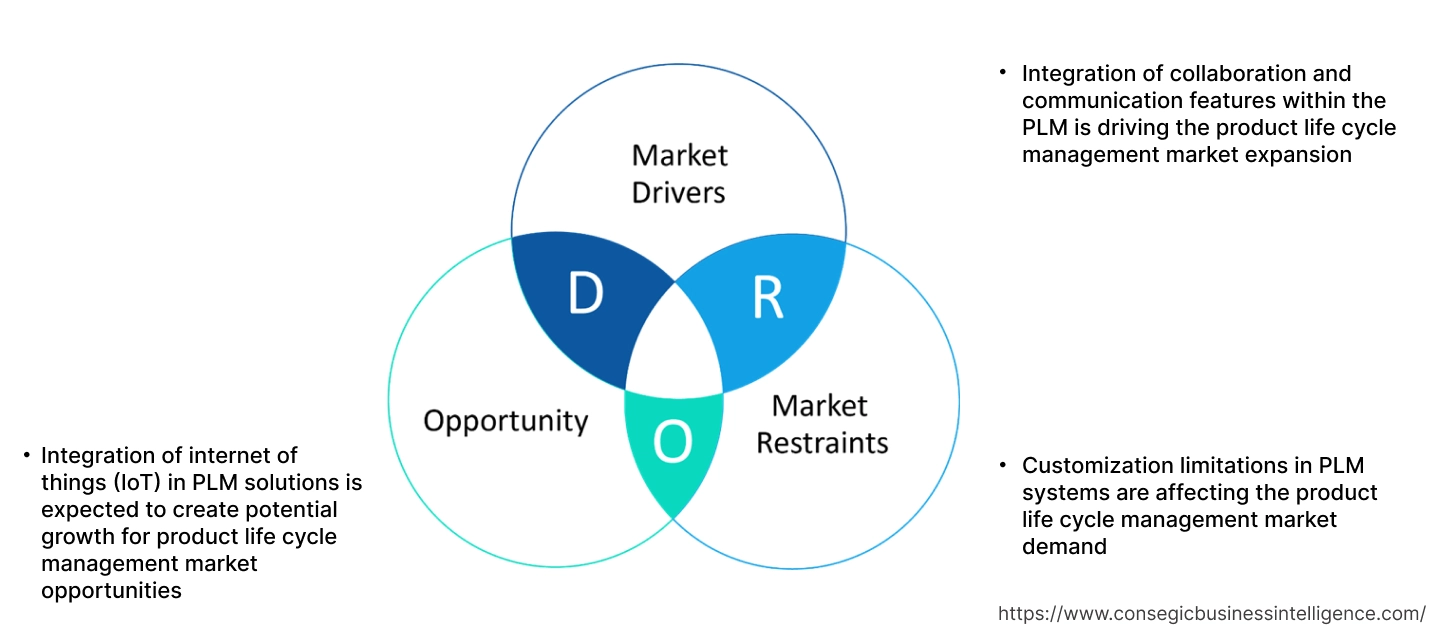- Summary
- Table Of Content
- Methodology
Product Life Cycle Management Market Size:
Product Life Cycle Management Market Size is estimated to reach over USD 69.13 Billion by 2032 from a value of USD 34.82 Billion in 2024 and is projected to grow by USD 37.30 Billion in 2025, growing at a CAGR of 9.0% from 2025 to 2032.
Product Life Cycle Management Market Scope & Overview:
Product life cycle management (PLM) is a strategic approach that manages a product from its initial concept to its retirement, encompassing all stages of development, manufacturing, marketing, and sales, aiming to improve efficiency and reduce costs. PLM facilitates seamless coordination and integration of key activities such as design, engineering, manufacturing, supply chain management, and customer service, enabling organizations to bring high-quality products to market faster, more efficiently, and at lower costs. Further, PLM empowers organizations to make informed decisions, optimize resources, and drive innovation across the entire value chain.
Key Drivers:
Integration of collaboration and communication features within the PLM is driving the product life cycle management market expansion
Collaboration and communication functionalities embedded within PLM platforms facilitate seamless interaction and information exchange among cross-functional teams, suppliers, partners, and even customers throughout every stage of the product lifecycle. By providing a centralized platform for sharing ideas, feedback, and insights, PLM solutions foster collaboration across dispersed teams, enabling them to work cohesively towards common goals and objectives. This collaborative approach not only enhances the quality and innovation of product designs but also accelerates the design process, reducing time-to-market and increasing agility in responding to changing market demands.
- For instance, in February 2023, Siemens announced the partnership with IBM, to accelerate the creation of environmentally friendly products and business practices, by developing software solutions for engineering and asset management. The companies have developed a unified software platform, which will link diverse engineering fields, such as mechanics, electronics, and software, enabling better tracking and more sustainable product lifecycles.
Thus, according to the product life cycle management market analysis, the integration of collaboration and communication features is driving the product life cycle management market size and trends.
Key Restraints:
Customization limitations in PLM systems are affecting the product life cycle management market demand
PLM systems offer structured frameworks for managing product development lifecycles, however, they may lack the flexibility needed to accommodate the diverse needs of different industries, organizations, and product types. Traditional PLM systems may struggle to address these business-specific challenges effectively.
For example, in the aerospace sector, where safety and compliance are critical, PLM systems must adhere to rigorous certification requirements and manage complex bill of materials (BOM) structures. Similarly, in healthcare, PLM solutions must comply with regulatory standards such as FDA regulations and manage sensitive patient data securely. Customizing PLM systems to meet these business-specific requirements can be time-consuming, costly, and technically challenging, limiting organizations' ability to leverage PLM effectively. Thus, the aforementioned factors would further impact on the product life cycle management market size.
Future Opportunities :
Integration of internet of things (IoT) in PLM solutions is expected to create potential growth for product life cycle management market opportunities
The incorporation of internet of things (IoT) has significantly expanded the capability of product life cycle management systems, particularly in monitoring real-time performance and ensuring quality after products are made. By embedding IoT sensors in intelligent products and systems, useful data can be created. Furthermore, progress in technologies like the industrial internet of things (IIoT), virtual reality (VR), augmented reality (AR), and 3D printing is expected to drive market. Consequently, the ability to rapidly adapt product innovation to meet evolving market demands has become crucial due to these constantly shifting factors. Product lifecycle management systems facilitate lower operating expenses and improved time management while fostering innovation in business processes. These advantages are anticipated to have a favorable influence on market expansion throughout the projected period.
- For instance, in February 2021, Siemens launched Assist AR 3.0, to support inspection, maintenance, and assembly procedures with a new-generation and AR technologies. It connects to company’s PLM system and services, which provide regular displays and PCs to guide company operators with complex business operations.
Thus, based on the above product life cycle management market analysis, the growing integration of internet of things (IoT) in PLM solutions is expected to drive the product life cycle management market opportunities and trends.
Product Life Cycle Management Market Segmental Analysis :
By Component:
Based on component, the market is segmented into software and services.
Trends in the component:
- By providing a centralized platform for managing product data, documents, and processes, PLM empowers organizations to make informed decisions, optimize resources, and drive innovation across the entire value chain.
- With growing consumer demand for eco-friendly products and ethical sourcing, organizations are leveraging PLM solutions to integrate sustainability considerations into product design, procurement, and manufacturing processes, thereby aligning business goals with environmental and social responsibilities.
- Thus, the above factors are driving the product life cycle management market demand and trends.
The software segment accounted for the largest revenue product life cycle management market in the year 2024.
- Software encompasses a wide range of digital tools, platforms, and applications designed to support product development, collaboration, and innovation throughout the product lifecycle.
- PLM software solutions offer diverse functionalities, including product data management (PDM), computer-aided design (CAD), computer-aided engineering (CAE), manufacturing operations management (MOM) simulation, digital manufacturing, and collaboration tools.
- These software applications enable organizations to streamline product development processes, manage product data and documentation, facilitate cross-functional collaboration, and optimize manufacturing and supply chain operations.
- With features such as version control, change management, and workflow automation, PLM software empowers companies to accelerate time-to-market, reduce costs, and improve product quality and innovation.
- For instance, in March 2024, Rockwell Automation announced the partnership with NVIDIA, to accelerate the development of advanced industrial framework. This partnership will integrate NVIDIA Omniverse Cloud's software connections (APIs) with Emulate3D, a tool from Rockwell Automation. It offers users better ways to share data between different systems, work together in real-time, and use precise visual representations. These improvements are intended to make it easier to design, build, and oversee detailed digital copies of large manufacturing operations.
- Thus, based on the above analysis, these factors are further driving the product life cycle management market growth.
The service segment is anticipated to register the fastest CAGR during the forecast period.
- Services complement PLM software offerings by providing implementation, consulting, training, and support services to help organizations maximize the value and ROI of their PLM investments.
- Service providers partner with organizations to assess their unique business needs, design tailored PLM solutions, and ensure successful implementation and adoption.
- Additionally, PLM services play a crucial role in helping organizations navigate digital transformation initiatives, adopt best practices, and address organizational change management challenges associated with PLM implementation.
- Thus, based on the above analysis, these factors are expected to drive the product life cycle management market share during the forecast period.
By Deployment:
Based on deployment, the market is segmented into on-premise and software-as-a-service.
Trends in the deployment:
- The rising complexity of global supply chains and the need for real-time collaboration are driving the development of the segment. As companies expand their operations globally, they require robust PLM deployment solutions that enable seamless collaboration across different time zones, departments, and external partners.
- The increasing focus on agile product development methodologies in industries such as consumer electronics, automotive, and aerospace, is driving the growth of the segment.
The on-premise segment accounted for the largest revenue share in the year 2024.
- On-premises PLM solutions are deployed and maintained within an organization's own infrastructure, providing greater control, customization, and data security as compared to cloud-based alternatives.
- This deployment model appeals to organizations with strict regulatory requirements, data privacy concerns, or legacy IT environments that prefer to maintain full ownership and control over their PLM systems.
- On-premises PLM solutions offer the flexibility to customize workflows, integrate with existing enterprise systems, and adhere to specific security protocols, ensuring alignment with organizational policies and standards.
- Moreover, on-premises deployments may be preferred by organizations with limited internet connectivity or bandwidth constraints, where offline access to PLM functionalities is critical for continuous operations.
- Therefore, these factors would further supplement the product life cycle management market
The software-as-a-service (SaaS) segment is anticipated to register the fastest CAGR during the forecast period.
- SaaS PLM solutions are hosted and managed by third-party providers, enabling businesses to access PLM functionalities through the internet without the need for on-site hardware or infrastructure investments.
- This deployment model appeals to organizations seeking rapid deployment, lower upfront costs, and the ability to scale resources according to changing business needs.
- Additionally, SaaS solutions offer enhanced collaboration capabilities, allowing geographically dispersed teams to collaborate seamlessly on product design, development, and management in real time, thereby improving productivity and accelerating time-to-market.
- For instance, in April 2025, Siemens introduced two new Teamcenter X tiers, Teamcenter X Premium and Teamcenter X Essentials, for its SaaS PLM portfolio. These two new preconfigured tiers aim to solve frequent challenges for Siemens’ customers to manage engineering data and processes across their enterprise.
- These developments in the SaaS segment are anticipated to further drive the product life cycle management market trends during the forecast period.
By End-User:
Based on end user, the market is segmented into aerospace & defense, automotive & transportation, healthcare, IT & telecom, industrial equipment & heavy machinery, retail, semiconductor & electronics, and others.
Trends in the end user:
- By digitizing and automating manual processes, PLM solutions help end users accelerate time-to-market, optimize inventory management, and ensure product quality and compliance with business standards and regulations.
- By integrating design, engineering, and manufacturing processes, companies can enhance collaboration with suppliers, optimize production workflows, and introduce new features to meet evolving consumer needs.
The automotive & transportation segment accounted for the largest revenue share of 22.40% in the year 2024.
- The automotive sector is increasingly turning to product life cycle management solutions to streamline software development processes for vehicle systems, telematics, and connected car
- PLM aids in managing the complexities of automotive software, ensuring compliance with industry standards, and enhancing collaboration among dispersed teams.
- With the rise of electric and autonomous vehicles, PLM solutions become necessary for managing the lifecycle of embedded software, ensuring safety, reliability, and interoperability.
- For instance, in March 2025, OPmobility has adopted Teamcenter X, a PLM software from the Siemens Xcelerator product portfolio. The company will use Teamcenter to optimize project lead-times and work efficiency, which will transform the design process in automotive sector.
- Thus, based on the above analysis, these factors are driving the product life cycle management market growth.
The healthcare segment is anticipated to register the fastest CAGR during the forecast period.
- The product life cycle management solutions enable healthcare sector to utilize streamline medical device development, ensure compliance with stringent regulatory standards, and enhance patient outcomes.
- Product life cycle solutions help pharmaceutical companies manage documentation, maintain compliances throughout the product lifecycle, track design changes, and eliminate the risk of non-compliance issues and potential penalties.
- By managing product data, documentation, and regulatory submissions, healthcare organizations can expedite product approvals, mitigate risks, and improve traceability throughout the product lifecycle, ultimately delivering safer and more effective medical devices to market.
- These factors are anticipated to further drive the product life cycle management market trends during the forecast period.

Regional Analysis:
The global market has been classified by region into North America, Europe, Asia-Pacific, Middle East & Africa, and Latin America.

Asia Pacific product life cycle management market expansion is estimated to reach over USD 18.22 billion by 2032 from a value of USD 8.88 billion in 2024 and is projected to grow by USD 9.54 billion in 2025. Out of this, the China market accounted for the maximum revenue split of 33.57%. The regional growth can be attributed to the growing manufacturing sector, expanding automotive and electronics industries, and increasing investments in digital transformation. Countries in the region are key contributors to the growth of the market, driven by factors such as industrialization, urbanization, and rising consumer demand. In Asia Pacific, PLM solutions play a crucial role in enabling companies to innovate rapidly, scale production efficiently, and compete globally. Industries such as automotive, electronics, consumer goods, and healthcare leverage product life cycle solutions to accelerate time-to-market, optimize supply chain operations, and comply with regulatory requirements. These factors would further drive the regional product life cycle management market during the forecast period.
- For instance, in February 2023, Bricsys announced the partnership with ITI Technegroup, a subsidiary of Wipro, to provide integration between Siemens’ Teamcenter software and BricsCAD. This partnership equips BricsCAD users with advanced functionalities that improve their design processes and make product development easier. The integration is anticipated to greatly boost productivity and efficiency in design and engineering by providing top-tier tools to simplify different stages of the design workflow.

North America market is estimated to reach over USD 24.43 billion by 2032 from a value of USD 12.37 billion in 2024 and is projected to grow by USD 13.24 billion in 2025. The region's advanced manufacturing capabilities, strong regulatory framework, and high adoption of digital technologies contribute to the demand for PLM solutions. In North America, PLM solutions focus on enabling innovation, enhancing collaboration, and ensuring compliance with stringent regulatory standards such as FDA regulations in the healthcare and aerospace sectors. Additionally, the region's emphasis on Industry 4.0 initiatives and digital transformation further accelerates the adoption of PLM solutions, particularly in industries characterized by complex product development lifecycles and supply chains. These factors would further drive the regional market.
- For instance, in June 2021, Accenture acquired DI Square, a Japanese IT company specializing in product lifecycle management (PLM) and application lifecycle management (ALM) systems integration, enhancing its engineering services for automotive and manufacturing clients. With this acquisition, they will assist clients in the digital transformation of their core operations, encompassing the design, development, manufacturing, and servicing of intelligent, connected products.
According to the analysis, the product life cycle management industry in Europe is projected to witness significant development during the forecast period. Industries such as automotive, aerospace, defense, and industrial machinery drive the need for PLM solutions in Europe, where companies prioritize innovation, efficiency, and compliance with European Union (EU) regulations. PLM solutions in Europe focus on supporting collaborative product development, optimizing manufacturing processes, and ensuring traceability and compliance with environmental and safety standards. Additionally, the Latin American regional growth can be attributed to the growing adoption of cloud-based PLM solutions and advanced technologies such as artificial intelligence (AI) and Internet of Things (IoT). Further, in the Middle East and Africa, sectors such as oil and gas, construction, and healthcare present opportunities for PLM adoption. PLM solutions in these regions focus on improving operational efficiency, driving innovation, and complying with business-specific regulations and standards.

Top Key Players and Market Share Insights:
The global product life cycle management market is highly competitive with major players providing solutions and services to the national and international markets. Key players are adopting several strategies in research and development (R&D), product innovation, and end-user launches to hold a strong position in the market. Key players in the product life cycle management industry include-
- PTC (U.S.)
- Siemens AG (Germany)
- Centric Software Inc. (U.S.)
- HCL Technologies Limited (India)
- Infor Inc. (U.S.)
- Dassault Systèmes SE (France)
- Autodesk Inc. (U.S.)
- SAP SE (Germany)
- Oracle Corporation (U.S.)
- Aras Corporation (U.S.)
Recent Industry Developments :
Merger & Acquisition:
- In January 2022, Aras announced the merger with Minerva Group, the Aras PLM implementation partner. With this merger, the companies will deliver enhanced product lifecycle management solutions for medical and industrial equipment manufacturing. Leveraging the Aras platform, Minerva has developed complete product life cycle management solutions tailored for companies who need to meet FDA regulations and those involved in high-tech electronics contract manufacturing.
Product Life Cycle Management Market Report Insights:
| Report Attributes | Report Details |
| Study Timeline | 2019-2032 |
| Market Size in 2032 | USD 69.13 Billion |
| CAGR (2025-2032) | 9.0% |
| By Component |
|
| By Deployment |
|
| By End-User |
|
| By Region |
|
| Key Players |
|
| North America | U.S. Canada Mexico |
| Europe | U.K. Germany France Spain Italy Russia Benelux Rest of Europe |
| APAC | China South Korea Japan India Australia ASEAN Rest of Asia-Pacific |
| Middle East and Africa | GCC Turkey South Africa Rest of MEA |
| LATAM | Brazil Argentina Chile Rest of LATAM |
| Report Coverage |
|
Key Questions Answered in the Report
How big is the Product Life Cycle Management Market? +
Product Life Cycle Management market size is estimated to reach over USD 69.13 Billion by 2032 from a value of USD 34.82 Billion in 2024 and is projected to grow by USD 37.30 Billion in 2025, growing at a CAGR of 9.0% from 2025 to 2032.
Which is the fastest-growing region in the Product Life Cycle Management Market? +
Asia-Pacific is the region experiencing the most rapid growth in the market.
What specific segmentation details are covered in the Product Life Cycle Management report? +
The product life cycle management report includes specific segmentation details for component, deployment, end user, and region.
Who are the major players in the Product Life Cycle Management Market? +
The key participants in the market are PTC (U.S.), Siemens AG (Germany), Dassault Systèmes SE (France), Autodesk Inc. (U.S.), SAP SE (Germany), Oracle Corporation (U.S.), Aras Corporation (U.S.), Centric Software Inc. (U.S.), HCL Technologies Limited (India), Infor Inc. (U.S.), and others.


